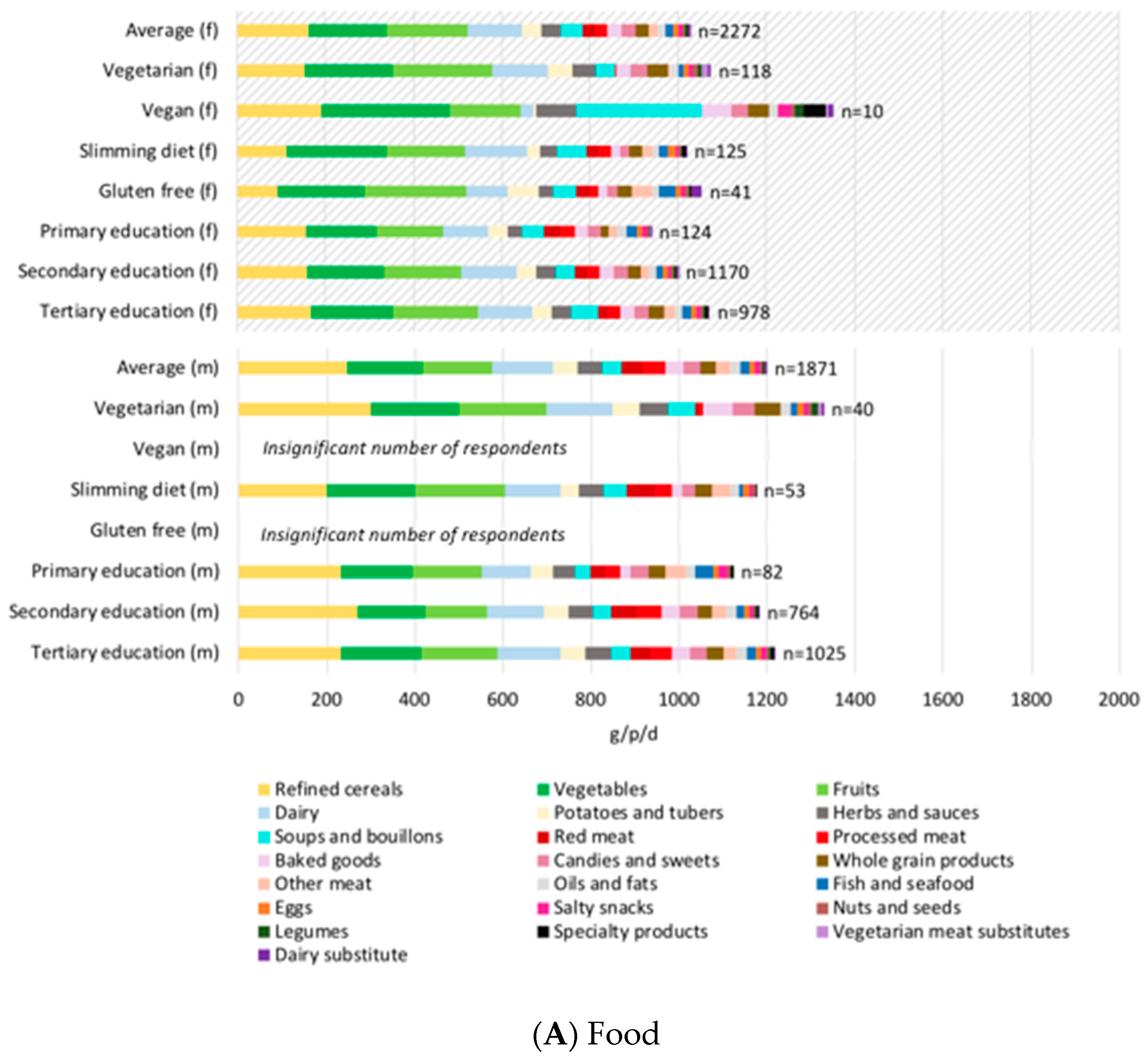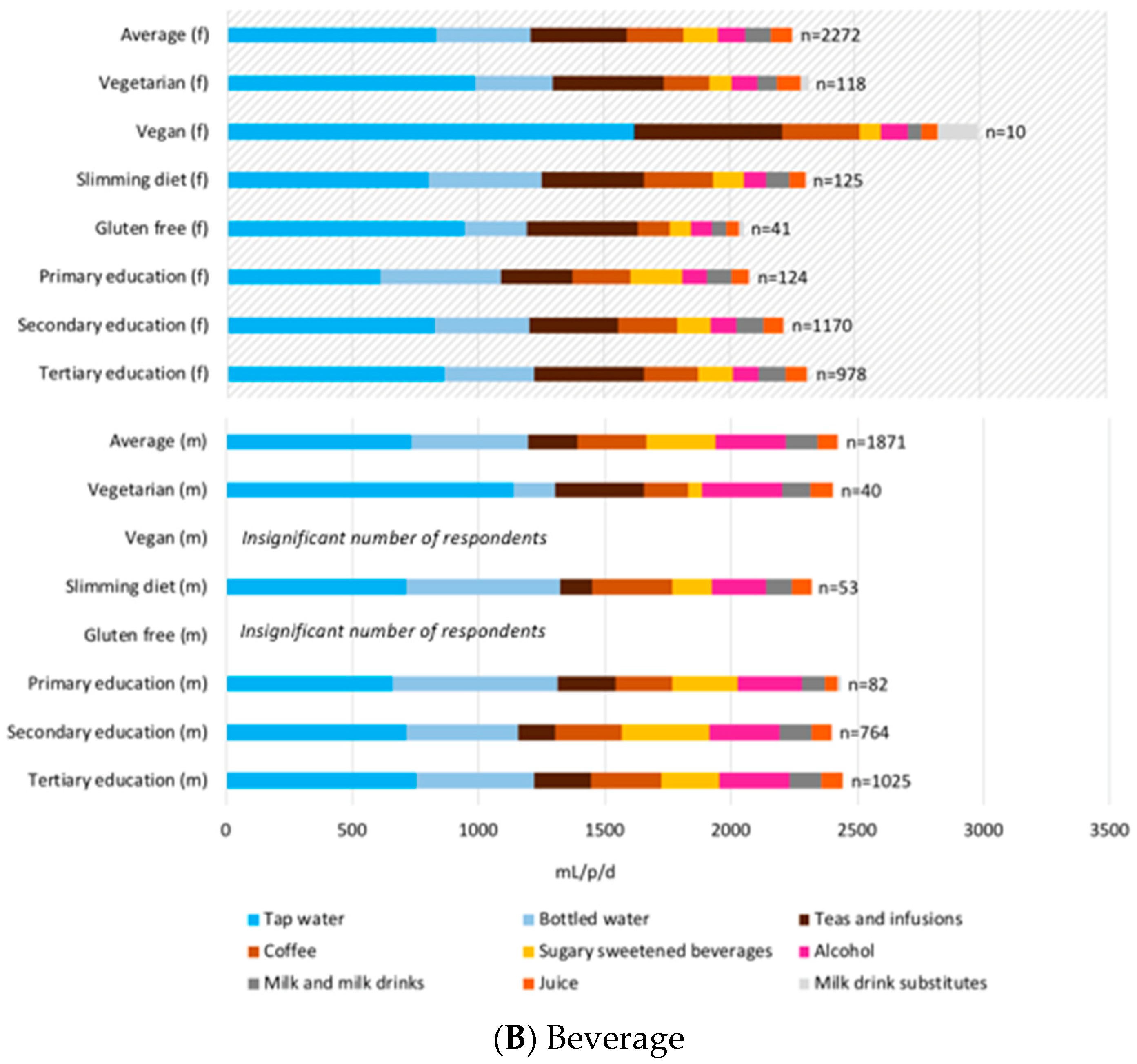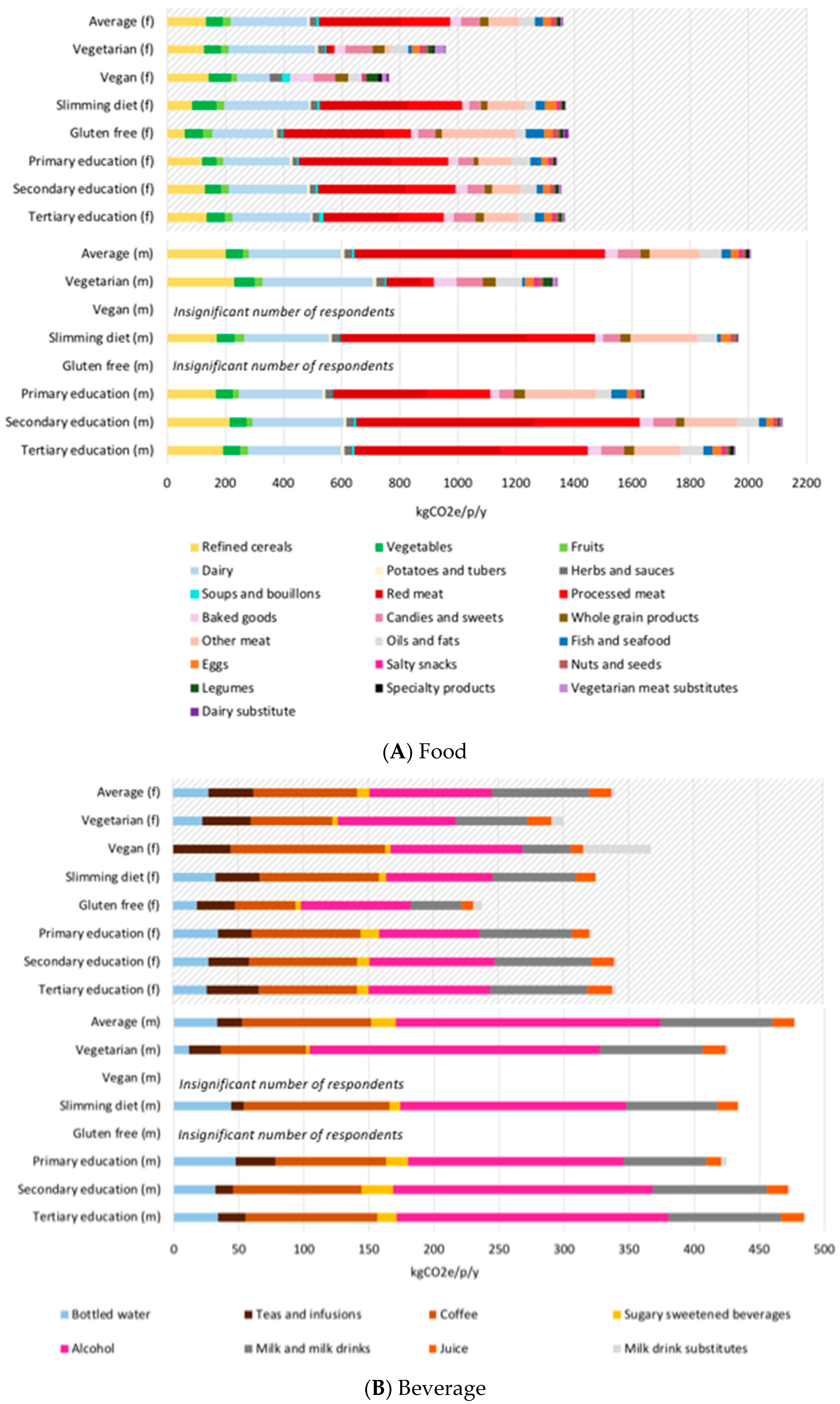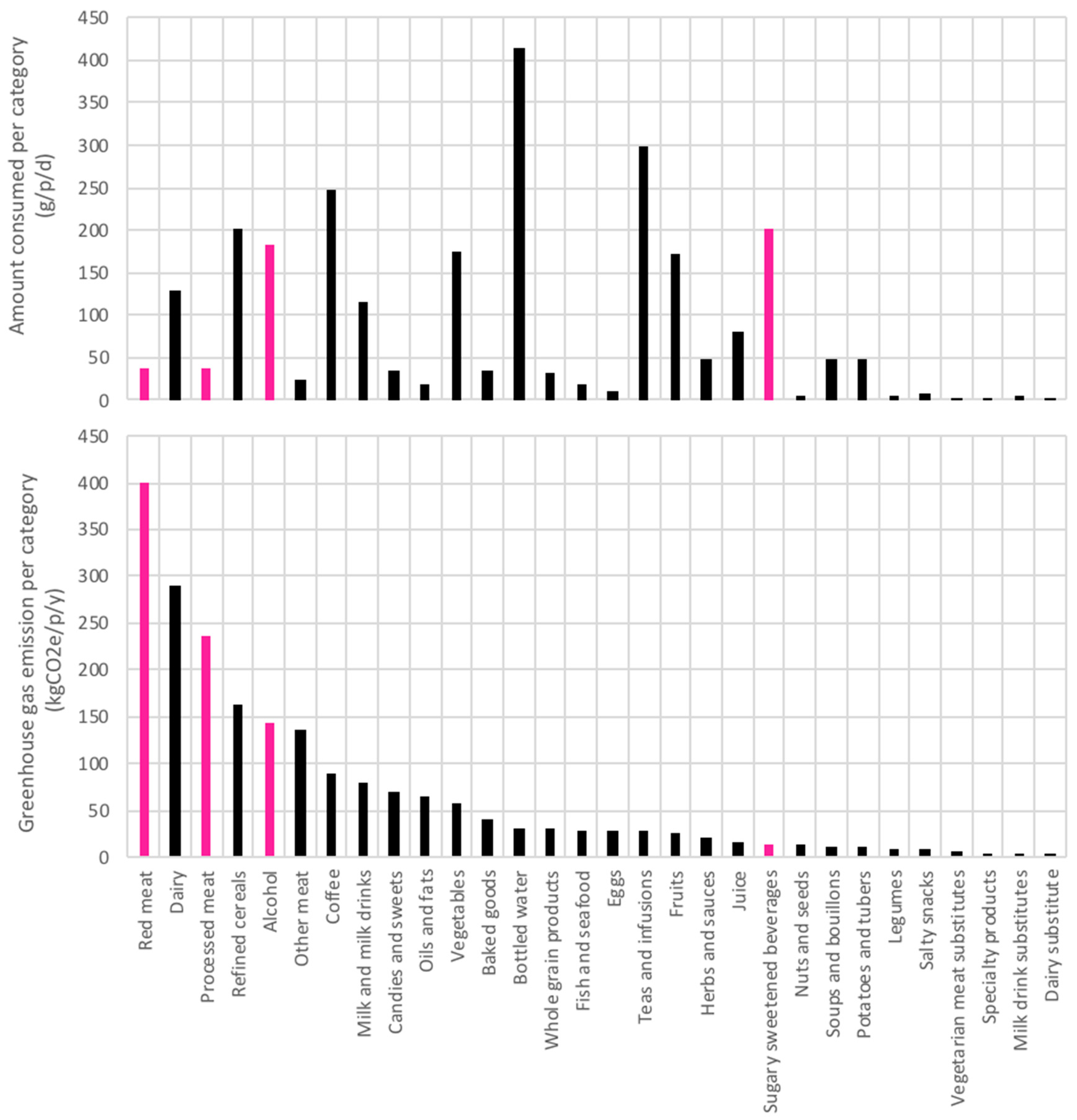Towards Win–Win Policies for Healthy and Sustainable Diets in Switzerland
Abstract
:1. Introduction
2. Materials and Methods
2.1. Bridging the Gap between Perception and Practice
2.2. Screening GHG of Dietary Surveys
2.3. Deriving a Relative Disease Burden Score for Screening
2.4. Determination of HENI-Relevant Food Groups and Nutrients Profile
3. Results
3.1. Consumption Results in Terms of Portion Size of Nutrients
3.2. GHG of Swiss Diets
3.3. Disease Burden Scores of Diets
4. Discussion and Limitations to the Study
5. Conclusions
Supplementary Materials
Author Contributions
Funding
Acknowledgments
Conflicts of Interest
References
- Springmann, M.; Wiebe, K.; Mason-D’Croz, D.; Sulser, T.B.; Rayner, M.; Scarborough, P. Health and nutritional aspects of sustainable diet strategies and their association with environmental impacts: A global modelling analysis with country-level detail. Lancet Planet. Health 2018, 2, e451–e461. [Google Scholar] [CrossRef] [Green Version]
- Willett, W.; Rockström, J.; Loken, B.; Springmann, M.; Lang, T.; Vermeulen, S.; Garnett, T.; Tilman, D.; Declerck, F.; Wood, A.; et al. Food in the Anthropocene: The EAT–Lancet Commission on healthy diets from sustainable food systems. Lancet 2019, 393, 447–492. [Google Scholar] [CrossRef]
- Moodie, R.; Stuckler, D.; Monteiro, C.; Sheron, N.; Neal, B.; Thamarangsi, T.; Lincoln, P.; Casswell, S.; Moodie, R. Profits and pandemics: Prevention of harmful effects of tobacco, alcohol, and ultra-processed food and drink industries. Lancet 2013, 381, 670–679. [Google Scholar] [CrossRef]
- Stuckler, D.; Nestle, M. Big Food, Food Systems, and Global Health. PLoS Med. 2012, 9, e1001242. [Google Scholar] [CrossRef] [PubMed]
- Monteiro, C.A.; Levy, R.B.; Claro, R.M.; De Castro, I.R.R.; Cannon, G. Increasing consumption of ultra-processed foods and likely impact on human health: Evidence from Brazil. Public Health Nutr. 2010, 14, 5–13. [Google Scholar] [CrossRef] [PubMed]
- Godin, L.; Sahakian, M. Cutting through conflicting prescriptions: How guidelines inform “healthy and sustainable” diets in Switzerland. Appetite 2018, 130, 123–133. [Google Scholar] [CrossRef]
- Plessz, M.; Dubuisson-Quellier, S.; Gojard, S.; Barrey, S. How consumption prescriptions affect food practices: Assessing the roles of household resources and life-course events. J. Consum. Cult. 2014, 16, 101–123. [Google Scholar] [CrossRef] [Green Version]
- Hallström, E.; Carlsson-Kanyama, A.; Börjesson, P.; C-Kanyama, A. Environmental impact of dietary change: A systematic review. J. Clean. Prod. 2015, 91, 1–11. [Google Scholar] [CrossRef]
- Chen, C.; Chaudhary, A.; Mathys, A. Dietary Change Scenarios and Implications for Environmental, Nutrition, Human Health and Economic Dimensions of Food Sustainability. Nutrients 2019, 11, 856. [Google Scholar] [CrossRef] [Green Version]
- menuCH. Switzerland—National Nutrition Survey menuCH 2014–2015. Available online: https://menuch.iumsp.ch/index.php/catalog/4 (accessed on 7 November 2018).
- Stylianou, K.; Fulgoni Victor, L.; Jolliet, O. Abstract P226: HEalth Nutritional Index (HENI): A Health Burden Based Tool for Food and Diet Nutritional Evaluation. Circulation 2018, 137, AP226. [Google Scholar] [CrossRef]
- Stylianou, K.S.; Fulgoni, V.L.; Jolliet, O. Identifying healthy and sustainable foods: Small dietary changes bring large benefits. Under review.
- Chatelan, A.; Marques-Vidal, P.; Bucher, S.; Siegenthaler, S.; Metzger, N.; Zuberbühler, C.A.; Camenzind-Frey, E.; Reggli, A.; Bochud, M.; Beer-Borst, S. Lessons Learnt About Conducting a Multilingual Nutrition Survey in Switzerland: Results from menuCH Pilot Survey. Int. J. Vitam. Nutr. Res. 2017, 87, 25–36. [Google Scholar] [CrossRef] [PubMed] [Green Version]
- Chatelan, A.; Beer-Borst, S.; Randriamiharisoa, A.; Pasquier, J.; Blanco, J.M.; Siegenthaler, S.; Paccaud, F.; Slimani, N.; Nicolas, G.; Camenzind-Frey, E.; et al. Major Differences in Diet across Three Linguistic Regions of Switzerland: Results from the First National Nutrition Survey menuCH. Nutrients 2017, 9, 1163. [Google Scholar] [CrossRef] [PubMed]
- In, B.M.; Curran, M.A. Life-Cycle Assessment: Inventory Guidelines and Principles; CRC Press: Boca Raton, FL, USA, 1994. [Google Scholar]
- Nemecek, T.; Bengoa, X.; Lansche, J.; Mouron, P.; Riedener, E.; Rossi, V.; Humbert, S. Methodological Guidelines for the Life Cycle Inventory of Agricultural Products; Version 3.0; World Food LCA Database (WFLDB); Quantis and Agroscope, Lausanne and Zurich: Zurich, Switzerland, 2015. [Google Scholar]
- Treyer, K.; Bauer, C. Life cycle inventories of electricity generation and power supply in version 3 of the ecoinvent database—Part I: Electricity generation. Int. J. Life Cycle Assess. 2013, 21, 1236–1254. [Google Scholar] [CrossRef]
- Hallström, E.; Håkansson, N.; Åkesson, A.; Wolk, A.; Sonesson, U. Climate impact of alcohol consumption in Sweden. J. Clean. Prod. 2018, 201, 287–294. [Google Scholar] [CrossRef]
- Blonk. Agri-Footprint; a Life Cycle Inventory Database Covering Food and Feed Production and Processing. 2014. Available online: http://www.agri-footprint.com/ (accessed on 7 November 2018).
- IPCC. AR5 Climate Change 2013: The Physical Science Basis—IPCC. 2013. Available online: https://www.ipcc.ch/report/ar5/wg1/ (accessed on 29 March 2020).
- Beretta, C.; Stucki, M.; Hellweg, S. Environmental Impacts and Hotspots of Food Losses: Value Chain Analysis of Swiss Food Consumption. Environ. Sci. Technol. 2017, 51, 11165–11173. [Google Scholar] [CrossRef]
- Gakidou, E.; Afshin, A.; Abajobir, A.A.; Abate, K.H.; Abbafati, C.; Abbas, K.M.; Abd-Allah, F.; Abdulle, A.M.; Abera, S.F.; Aboyans, V.; et al. Global, regional, and national comparative risk assessment of 84 behavioural, environmental and occupational, and metabolic risks or clusters of risks, 1990–2016: A systematic analysis for the Global Burden of Disease Study 2016. Lancet 2017, 390, 1345–1422. [Google Scholar] [CrossRef] [Green Version]
- Institute for Health Metrics and Evaluation (IHME). Global Burden of Disease Collaborative Network, “Global Burden of Disease Study 2016 (GBD 2016) Population Estimates 1950–2016”. Available online: http://ghdx.healthdata.org/record/global-burden-disease-study-2016-gbd-2016-population-estimates-1950-2016 (accessed on 15 October 2019).
- Weidema, B.P.; Stylianou, K.S. Nutrition in the life cycle assessment of foods—Function or impact? Int. J. Life Cycle Assess. 2020, 25, 1210–1216. [Google Scholar] [CrossRef]
- Zelber-Sagi, S.; Ivancovsky-Wajcman, D.; Fliss-Isakov, N.; Webb, M.; Orenstein, D.; Shibolet, O.; Kariv, R. High red and processed meat consumption is associated with non-alcoholic fatty liver disease and insulin resistance. J. Hepatol. 2018, 68, 1239–1246. [Google Scholar] [CrossRef]
- CDC. NHANES 2011–2012 Dietary Data. 2014. Available online: https://wwwn.cdc.gov/nchs/nhanes/Search/DataPage.aspx?Component=Dietary&CycleBeginYear=2011 (accessed on 28 January 2018).
- World Health Organization. Eliminating Trans Fats in Europe. 31 March 2020. Available online: http://www.euro.who.int/en/countries/switzerland/news/news/2015/09/eliminating-trans-fats-in-europe (accessed on 21 September 2015).
- Notarnicola, B.; Tassielli, G.; Renzulli, P.A.; Castellani, V.; Sala, S. Environmental impacts of food consumption in Europe. J. Clean. Prod. 2017, 140, 753–765. [Google Scholar] [CrossRef]
- Rose, D.; Heller, M.; Willits-Smith, A.M.; Meyer, R.J. Carbon footprint of self-selected US diets: Nutritional, demographic, and behavioral correlates. Am. J. Clin. Nutr. 2019, 109, 526–534. [Google Scholar] [CrossRef] [Green Version]
- Sahakian, M.; Godin, L.; Courtin, I. Promoting ‘pro’, ‘low’, and ‘no’ meat consumption in Switzerland: The role of emotions in practices. Appetite 2020, 150, 104637. [Google Scholar] [CrossRef] [PubMed] [Green Version]
- Kanter, R.; Villagra, M.L. Participatory Methods to Identify Perceived Healthy and Sustainable Traditional Culinary Preparations across Three Generations of Adults: Results from Chile’s Metropolitan Region and Region of La Araucanía. Nutrients 2020, 12, 489. [Google Scholar] [CrossRef] [PubMed] [Green Version]
- Eker, S.; Reese, G.; Obersteiner, M. Modelling the drivers of a widespread shift to sustainable diets. Nat. Sustain. 2019, 2, 725–735. [Google Scholar] [CrossRef] [Green Version]
- Born, B.; Purcell, M. Avoiding the Local Trap. J. Plan. Educ. Res. 2006, 26, 195–207. [Google Scholar] [CrossRef]
- Perrin, O. Les #grilétariens de Migros font tousser sur le Net. Le Temps. Available online: https://www.letemps.ch/opinions/griletariens-migros-tousser-net (accessed on 15 October 2019).
- DiMeglio, D.P.; Mattes, R.D. Liquid versus solid carbohydrate: Effects on food intake and body weight. Int. J. Obes. 2000, 24, 794–800. [Google Scholar] [CrossRef] [Green Version]
- Astrup, A.; Magkos, F.; Bier, D.M.; Brenna, J.T.; Otto, M.C.D.O.; Hill, J.O.; King, J.C.; Mente, A.; Ordovas, J.M.; Volek, J.S.; et al. Saturated Fats and Health: A Reassessment and Proposal for Food-Based Recommendations. J. Am. Coll. Cardiol. 2020, 76, 844–857. [Google Scholar] [CrossRef]
- Dietary Reference Values for nutrients Summary report. EFSA Support. Publ. 2017, 14. [CrossRef] [Green Version]
- Office of Dietary Supplements—Riboflavin. Available online: https://ods.od.nih.gov/factsheets/Riboflavin-HealthProfessional/ (accessed on 31 March 2020).
- Dettling, J.; Qingshi, T.; Faist, M.; DelDuce, A.; Mandlebaum, S. A comparative Life Cycle Assessment of Plant-Based Foods and Meat Foods, ISO Compliant Report. 2016. Available online: https://www.morningstarfarms.com/content/dam/morningstarfarms/pdf/MSFPlantBasedLCAReport_2016-04-10_Final.pdf (accessed on 7 November 2018).
- Boulay, A.-M.; Lenoir, L.; Manzardo, A. Bridging the Data Gap in the Water Scarcity Footprint by Using Crop-Specific AWARE Factors. Water 2019, 11, 2634. [Google Scholar] [CrossRef] [Green Version]
- Zhan, Y.; Zhang, M. Spatial and temporal patterns of pesticide use on California almonds and associated risks to the surrounding environment. Sci. Total. Environ. 2014, 472, 517–529. [Google Scholar] [CrossRef]
- Grant, C.A.; Hicks, A. Comparative Life Cycle Assessment of Milk and Plant-Based Alternatives. Environ. Eng. Sci. 2018, 35, 1235–1247. [Google Scholar] [CrossRef]
- dairyreporter.com. Government Survey Shows Swiss aren’t Eating Enough Dairy. In Dairyreporter.com [Internet]. Available online: https://www.dairyreporter.com/Article/2017/03/20/Government-survey-shows-Swiss-aren-t-eating-enough-dairy (accessed on 31 March 2020).
- De Vries, M.; De Boer, I. Comparing environmental impacts for livestock products: A review of life cycle assessments. Livest. Sci. 2010, 128, 1–11. [Google Scholar] [CrossRef]
- Tichenor, N.E.; Peters, C.J.; Norris, G.A.; Thoma, G.; Griffin, T.S. Life cycle environmental consequences of grass-fed and dairy beef production systems in the Northeastern United States. J. Clean. Prod. 2017, 142, 1619–1628. [Google Scholar] [CrossRef]
- Nemecek, T.; Haupt, C.; Hofer, N.; Roesch, A.; Gazzarin, A. Analysis of options to increase the sustainability in the Swiss dairy sector—A literature review. Grassl. Sci. Eur. 2019, 24, 170–181. [Google Scholar]
- Boehm, R.; Wilde, P.; Ploeg, M.V.; Costello, C.; Cash, S.B. A Comprehensive Life Cycle Assessment of Greenhouse Gas Emissions from U.S. Household Food Choices. Food Policy 2018, 79, 67–76. [Google Scholar] [CrossRef]
- Niles, M.T.; Ahuja, R.; Barker, T.; Esquivel, J.; Gutterman, S.; Heller, M.C.; Mango, N.; Portner, D.; Raimond, R.; Tirado, C.; et al. Climate change mitigation beyond agriculture: A review of food system opportunities and implications. Renew. Agric. Food Syst. 2018, 33, 297–308. [Google Scholar] [CrossRef]
- FOEN Federal Office for the Environment. Climate: In Brief. 2019. Available online: https://www.bafu.admin.ch/bafu/en/home/themen/thema-klima/klima--das-wichtigste-in-kuerze.html (accessed on 1 May 2020).
- Rockström, J.; Steffen, W.; Noone, K.; Persson, Å.; Chapin, F.S.; Lambin, E.F.; Lenton, T.M.; Scheffer, M.; Folke, C.; Schellnhuber, H.J.; et al. A safe operating space for humanity. Nature 2009, 461, 472–475. [Google Scholar] [CrossRef]
- Springmann, M.; Clark, M.; Mason-D’Croz, D.; Wiebe, K.D.; Bodirsky, B.L.; Lassaletta, L.; De Vries, W.; Vermeulen, S.J.; Herrero, M.; Carlson, K.M.; et al. Options for keeping the food system within environmental limits. Nature 2018, 562, 519–525. [Google Scholar] [CrossRef]
- Jonnalagadda, S.S.; Mitchell, D.C.; Smiciklas-Wright, H.; Meaker, K.B.; Van Heel, N.; Karmally, W.; Ershow, A.G.; Kris-Etherton, P.M. Accuracy of Energy Intake Data Estimated by a Multiplepass, 24-hour Dietary Recall Technique. J. Am. Diet. Assoc. 2000, 100, 303–311. [Google Scholar] [CrossRef]
- Afshin, A.; Sur, P.J.; Fay, K.A.; Cornaby, L.; Ferrara, G.; Salama, J.S.; Mullany, E.C.; Abate, K.H.; Abbafati, C.; Abebe, Z.; et al. Health effects of dietary risks in 195 countries, 1990–2017: A systematic analysis for the Global Burden of Disease Study 2017. Lancet 2019, 393, 1958–1972. [Google Scholar] [CrossRef] [Green Version]






| Food | Beverage | |||||
|---|---|---|---|---|---|---|
| Mass | Dry Mass | Energy | Volume | Dry Mass | Energy | |
| kg/p/d | g/p/d | kcal/p/d | L/p/d | g/p/d | kcal/p/d | |
| Average | 1.1 | 384 | 1867 | 2.3 | 62 | 311 |
| Vegetarian | 1.1 | 382 | 1855 | 2.4 | 47 | 249 |
| Vegan * | 1.5 | 481 | 2338 | 3.0 | 60 | 415 |
| Slimming | 1.1 | 329 | 1597 | 2.3 | 45 | 217 |
| Gluten free | 1.0 | 306 | 1497 | 2.0 | 38 | 184 |
| Primary education | 1.0 | 353 | 1716 | 2.2 | 58 | 286 |
| Secondary education | 1.1 | 375 | 1824 | 2.3 | 62 | 311 |
| Tertiary education | 1.1 | 396 | 1925 | 2.4 | 62 | 313 |
| Women | 1.0 | 389 | 1643 | 2.3 | 50 | 255 |
| Men | 1.2 | 439 | 2140 | 2.4 | 76 | 378 |
| Disease Burden Score | Total GHG | Total GHG Scaled for 2000 Kcal Day | Food | Beverage | ||||
|---|---|---|---|---|---|---|---|---|
| μDALY/p/d | tCO2e/p/y | tCO2e/p/y | tCO2e/p/y | kgCO2e/kg | gCO2e/kcal | tCO2e/p/y | kgCO2e/L | |
| Average | 120 | 2.1 | 1.8 | 1.7 | 4.1 | 2.3 | 0.4 | 0.5 |
| Vegetarian | 88 | 1.4 | 1.1 | 1.1 | 2.5 | 1.6 | 0.3 | 0.4 |
| Vegan * | 69 | 1.3 | 0.9 | 1.0 | 1.8 | 1.2 | 0.3 | 0.3 |
| Slimming | 99 | 1.9 | 1.9 | 1.5 | 4.0 | 2.5 | 0.4 | 0.4 |
| Gluten free | 98 | 1.7 | 1.9 | 1.4 | 3.7 | 2.2 | 0.3 | 0.3 |
| Primary education | 119 | 1.8 | 1.7 | 1.5 | 4.0 | 2.2 | 0.4 | 0.4 |
| Secondary education | 123 | 2.0 | 1.8 | 1.7 | 4.2 | 2.3 | 0.4 | 0.5 |
| Tertiary education | 116 | 2.1 | 1.7 | 1.7 | 4.0 | 2.2 | 0.4 | 0.5 |
| Women | 105 | 1.7 | 1.7 | 1.4 | 3.6 | 2.2 | 0.3 | 0.4 |
| Men | 136 | 2.5 | 1.9 | 2.0 | 4.6 | 2.4 | 0.5 | 0.5 |
© 2020 by the authors. Licensee MDPI, Basel, Switzerland. This article is an open access article distributed under the terms and conditions of the Creative Commons Attribution (CC BY) license (http://creativecommons.org/licenses/by/4.0/).
Share and Cite
Ernstoff, A.; Stylianou, K.S.; Sahakian, M.; Godin, L.; Dauriat, A.; Humbert, S.; Erkman, S.; Jolliet, O. Towards Win–Win Policies for Healthy and Sustainable Diets in Switzerland. Nutrients 2020, 12, 2745. https://doi.org/10.3390/nu12092745
Ernstoff A, Stylianou KS, Sahakian M, Godin L, Dauriat A, Humbert S, Erkman S, Jolliet O. Towards Win–Win Policies for Healthy and Sustainable Diets in Switzerland. Nutrients. 2020; 12(9):2745. https://doi.org/10.3390/nu12092745
Chicago/Turabian StyleErnstoff, Alexi, Katerina S. Stylianou, Marlyne Sahakian, Laurence Godin, Arnaud Dauriat, Sebastien Humbert, Suren Erkman, and Olivier Jolliet. 2020. "Towards Win–Win Policies for Healthy and Sustainable Diets in Switzerland" Nutrients 12, no. 9: 2745. https://doi.org/10.3390/nu12092745
APA StyleErnstoff, A., Stylianou, K. S., Sahakian, M., Godin, L., Dauriat, A., Humbert, S., Erkman, S., & Jolliet, O. (2020). Towards Win–Win Policies for Healthy and Sustainable Diets in Switzerland. Nutrients, 12(9), 2745. https://doi.org/10.3390/nu12092745






